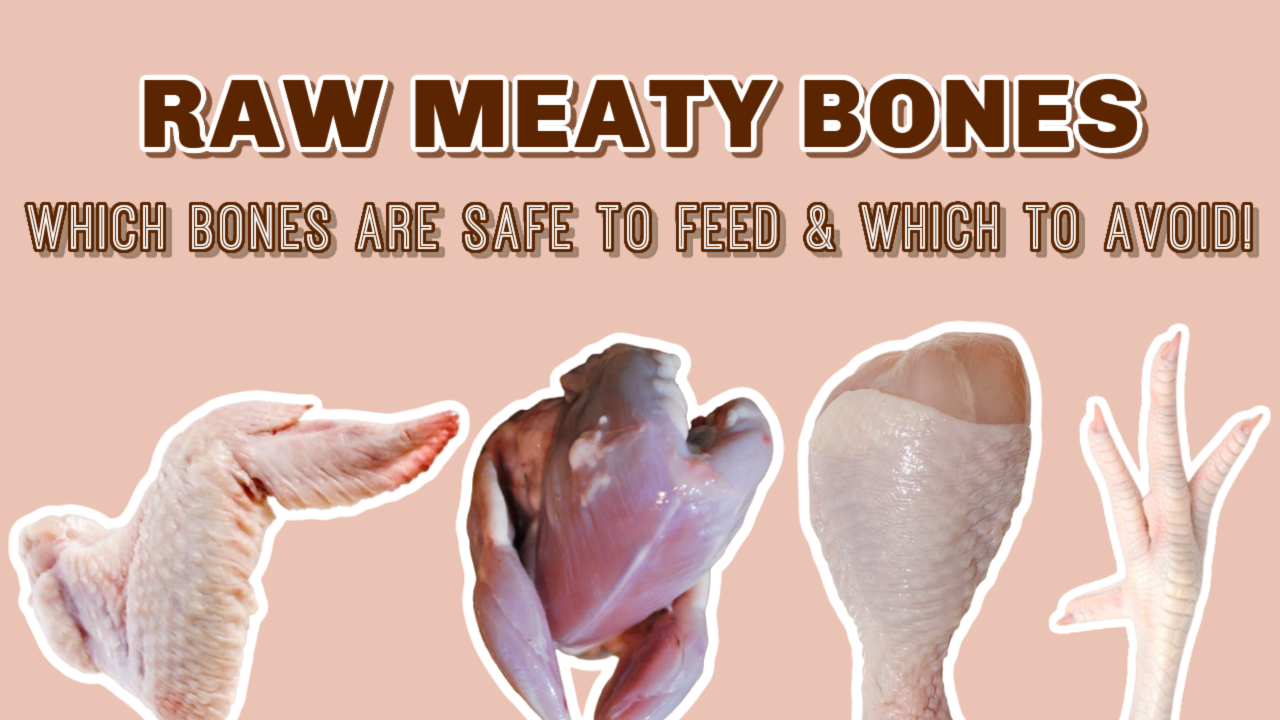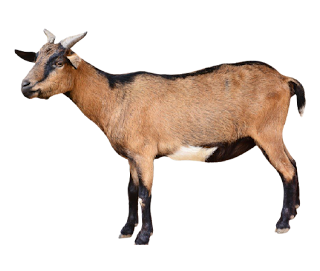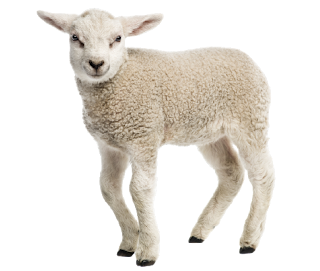I think the #1 question I get on Instagram from new raw feeders, has to be, "What bones do you feed to your dogs & which bones are safe for dogs/cats?"
Raw meaty bones (RMBs) are an excellent source of calcium, phosphorus & magnesium in a balanced raw diet (bones also provide varying amounts of other essential nutrients). If you follow a ratio diet, like PMR (Prey Model Raw) or BARF (Biologically Appropriate Raw Foods), then raw meaty bones can make up anywhere from 10% - 17% of your pet's diet (this varies by life stage). Remember to factor the muscle meat on your RMBs into the muscle meat portion of your ratio diet, for more information, check out my Raw Meaty Bone Percentage Spreadsheet!
Not all RMBs are created equal. It is your responsibility to feed the appropriate bones to your pet!
That means feeding ribs from appropriate animals & in pairs (or groups of 3+), steering clear of weight bearing bones, save those for some DIY bone broth, but it also means selecting appropriately sized RMBs for your pet.
**IMPORTANT NOTE**
Remember the nutrient content in every RMB varies. Substituting one for another may impact the nutrient breakdown of a balanced recipe, so be sure to do your research before swapping out bones in a balanced recipe!
Nutritional data can be found on the United States Department of Agriculture FoodData Search site!
In some instances, external resources are required when gathering the nutritional data on some raw meaty bones because they are not listed on the usda's site. I have personally purchased additional reading materials that detail animal/canine nutrition and provide specifics on some RMBs. If available to you, Monica Segal's books are one source that can provide such information to you as well!
If you didn't know, I have 2 dogs- an adult 33lb male and a 25lb 7 month old male puppy. Currently, both of my dogs can generally consume the same raw meaty bones without issues. Because I tend to get the most questions about feeding bones, I thought it would be helpful to share all of the raw meaty bones I feed to my dogs and the ones I recommend avoiding!
CHICKEN
Chicken Wings
Chicken Feet
Chicken Necks
Chicken Backs
Chicken Heads
Chicken Frames ("Carcass")
Chicken Thighs
Chicken Quarters (Thigh & Leg/Drumstick)
Chicken Drumsticks
(Chicken drumsticks are generally denser than other raw meaty bones from chicken and can sometimes be difficult for some dogs to digest - though many pet parents with larger breeds have no issues feeding chicken drumsticks!)
DUCK
Duck Wings
Duck Feet
Duck Necks
Duck Backs
Duck Heads
Duck Frames ("Carcass")
Duck Thighs
Duck Quarters (Thigh & Leg/Drumstick)
Duck Drumsticks
(Duck drumsticks are generally denser than other raw meaty bones from duck and can sometimes be difficult for some dogs to digest - though many pet parents with larger breeds have no issues feeding them!)
GOAT
Goat Ribs
(Always feed in pairs or groups of 3+. My dogs have no issues properly chewing & digesting goat ribs, but many dogs have a hard time properly digesting ribs & you may find fragments of bone in the stool. If this happens, you can introduce digestive enzymes or opt for a different, softer, raw meaty bone!)
Goat Heads
Goat Tails
Goat Trotters ("Feet" not Leg)
(Goat Feet can sometimes splinter or be a bit difficult for some dogs to digest, though many pet parents with larger breeds have no issues feeding them!)
LAMB
Lamb Ribs
(Always feed in pairs or groups of 3+. My dogs have no issues properly chewing & digesting lamb ribs, but many dogs have a hard time properly digesting ribs & you may find fragments of bone in the stool. If this happens, you can introduce digestive enzymes or opt for a different, softer, raw meaty bone!)
Lamb Heads
Lamb Tails
Lamb Trotters ("Feet" not Leg)
(Lamb Feet can sometimes splinter or be a bit difficult for some dogs to digest, though many pet parents with larger breeds have no issues feeding them!)
PIG
Pork Ribs
(Always feed in pairs or groups of 3+. My dogs have no issues properly chewing & digesting pork ribs, but many dogs have a hard time properly digesting ribs & you may find fragments of bone in the stool. If this happens, you can introduce digestive enzymes or opt for a different, softer, raw meaty bone!)
Pork Trotters ("Feet")
(I do not currently feed pig's feet to my dogs because they are a large raw meaty bone, they contain a lot of raw fat, & pork feet are denser than other raw meaty bones I often feed. Pork trotters can sometimes be difficult for some dogs to digest, though many pet parents with larger breeds have no issues feeding them!)
Pork Tails
Pig Heads
QUAIL, SQUAB (Pigeon), & Other Small Birds
Entire Bird
(My dogs have zero issues consuming the entire bird; from head-to-toe, feathers & all!)
RABBIT
Entire Rabbit
(My dogs have zero issues consuming the entire rabbit; from head-to-toe, fur & all!)
TURKEY
Turkey Necks
Turkey Heads
Turkey Frames ("Carcass")
Turkey bones tend to be denser when compared to other poultry bones (ie. chicken or duck raw meaty bones). I do NOT recommend feeding turkey legs ("turkey drumsticks") or the majority of a turkey wing as the raw meaty bone portion of your pet's diet because they tend to splinter, even when raw, and may be difficult for most dogs to fully digest. You can, however, remove all skin and meat to feed & save the bones for a yummy bone broth!
Monitor your pet's stool to see how they have digested these raw bones before continuing to include raw turkey bones in their diet. If there are shards of undigested bone in their stool, it may be best to switch to "softer" bones that may be digested more easily (ie. bones from chicken, duck, quail, rabbit etc).
If you believe your pet to have sustained an injury from ingesting a raw meaty bone, or that there may be a blockage, seek professional medical help IMMEDIATELY!
RAW MEATY BONES TO AVOID FEEDING PETS
Cooked Bones
(including smoked & dehydrated store bought bones)
All Beef Bones
(unless finely ground)
Weight-Bearing Bones from Large Animals/Mammals
("Soup bones" like femurs/knuckles & bones sold as recreational chews are very popular, but can pose a tooth fracture risk; weight-bearing bones can also file down your pet's teeth over time!)
"Naked" Machine Cut Bones
(like exposed pork chops; machine-cut bones like ribs are safe because meat covers the entire bone & it is a blunt cut, unlike machine-cut bones that show exposed bones & are cut at an angle)
--------
Hope this was helpful to some!



















Post a Comment
Note: Only a member of this blog may post a comment.